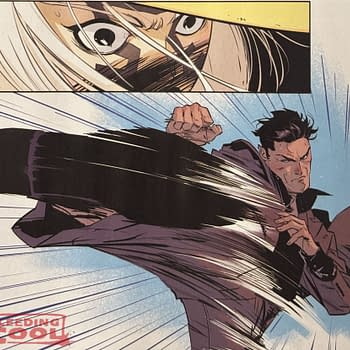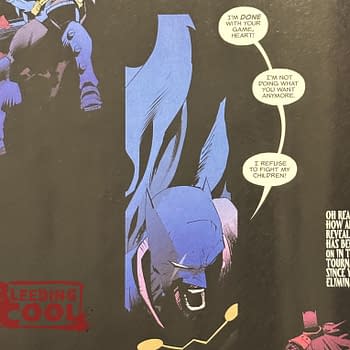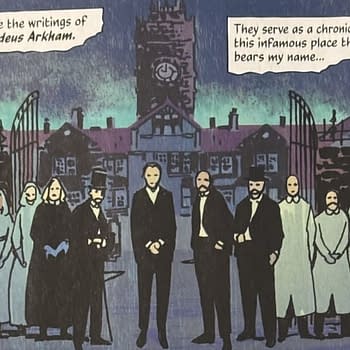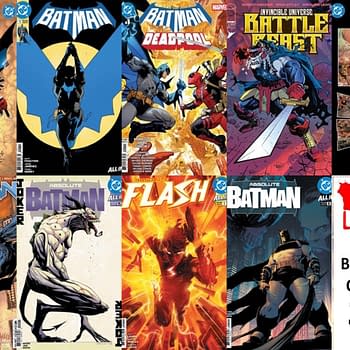Posted in: Comics | Tagged: avatar press, Comics, garth ennis, michael dipascale, rover red charlie
Garth Ennis And Michael Dipascale Talk Rover Red Charlie
Rover Red Charlie is the new mini-series from Garth Ennis and Michael Dipascale. It tells the an apocalyptical tale from a trio with wagging tails. Order for the first issue in this very unique series from Avatar Press are due in by Thursday 10/24.
I got a chance to speak with both Ennis and Dipascale about this new project:
BLEEDING COOL: You probably haven't been offered too many post apocalyptic dog stories, what made you want to take this project on?
MICHAEL DIPASCALE: Two words Garth Ennis!If it was any other writer than Garth, I probably wouldn't have done it.
BC: Where did the concept of telling an apocalyptic story through the eyes of pets come from? And why dogs?
GARTH ENNIS: The specific idea for Rover Red Charlie began when I figured out what dogs are saying to each other when they bark. And, really, has the simple notion of loyalty ever been more perfectly personified than in the face of a dog?
More generally, when I was a little kid there was an old painting in my Grandparents' farmhouse entitled "Faithful Friends", depicting three brave-looking dogs apparently ready to face whatever comes their way- it's hanging on the wall of my office now. They don't look much like Rover, Red and Charlie (who are at best brave-ish), but I suppose I've been waiting 35-40 years to send them on an adventure.

MD: Approaching the canine characters in this story was no different than how I approach any other characters. I am a dog lover so it really came easy to me. At first there was a lot of photo reference because of the 3 different breeds that were involved. As I got farther into the stories I was able to use my own dog's movements and transfer then onto the characters in the series.
It was very difficult at first to convey their expressions,we didn't want the dogs to look animated, and we wanted a more lifelike interpretation of them. William Christensen and Garth suggested they look more anthropomorphic. The success of the story hinged on being able to correctly convey the emotions of the dogs so it was important that I got it right. So I gave their faces just a bit more of a cartoon look while still being able to make them look realistic.
BC: Were the breeds of dog for Rover, Red and Charlie chosen for into their personality?
GE: Rover's English; he's a Basset Hound because of that fantastic long-suffering expression they have, which goes along with his "Bloody hell, not again" personality. Red's a Red Setter for obvious reasons: his name, and his incredibly small brain. And Charlie's a mutt because, as I understand it, something in their make-up means they can be quite good working dogs- they're smart little guys, in that regard.
No disrespect to working dogs who aren't mutts, of course.

MD: Garths scripts are not as detailed as one would think, but there are times when he is very specific and lets you know exactly what he wants to see on the page. The subway and surrounding areas including Grand Central station were very important to Garth. He really needed me to get it right. At times I had trouble because I have never been to New York, so I struggled conveying what he described. Garth actually went and took pictures of the subways for me for reference and that was a huge help. I didn't ask and I don't believe he knew I was having a hard time. He did it just to be helpful.
It really depends on how descriptive Garth is on his details. If he is specific about what he wants that is exactly what I draw. When he is less detailed, I have more freedom to interpret the scene.
BC: What is your artistic process? What are the steps you take from getting the script to turning in the final pages?
MD: First thing is do is completely read the script without interruption. After that I go through and thumb nail out the panel configuration for each page. I take into account certain panels that Garth wants large or small and the amount of dialog that goes into each panel. Then I am ready to start roughing out the scenes.
I start by taking a 9×12 sheet of paper and folding it in half. Each sheet of paper will then get 2 pages of story. Next I very roughly draw in the scenes as described in the script. I scan that into the computer and I send them off to William for his and Garth's approval. Once they give me the OK, I take the scanned pages and open them up in Corel Painter and lay them over a page template I have. Using the program then like a light box, I draw over the roughs adding all of the detail and expression that the story requires. Off to William and Garth for approval and then I begin to paint once again using Corel Painter. I paint every page and cover.

MD: That's easy, because it is a story. Sometimes it is a bit difficult to draw, but you have to remind yourself that it is just a story. I don't think what Garth wrote was meant to be viewed as violence for the sake of violence, it is not a book that is looking for shock value. Just because Garth's name is attached to the project, everyone assumes that the book will be riddled with violence and vulgarity when in fact it's more a book about friendship and camaraderie and how these characters get through dire events. People will be satisfied with what a truly great story this is.














